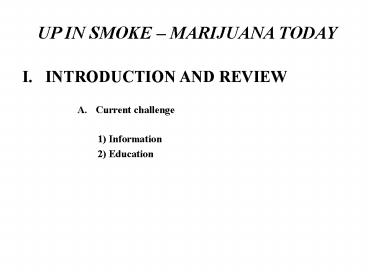INTRODUCTION AND REVIEW - PowerPoint PPT Presentation
Title:
INTRODUCTION AND REVIEW
Description:
UP IN SMOKE MARIJUANA TODAY INTRODUCTION AND REVIEW Current challenge 1) Information 2) Education DRUGS OF REWARD AND THE BRAIN Neuropharmacology of Marijuana 1 ... – PowerPoint PPT presentation
Number of Views:68
Avg rating:3.0/5.0
Title: INTRODUCTION AND REVIEW
1
UP IN SMOKE MARIJUANA TODAY
- INTRODUCTION AND REVIEW
- Current challenge
- 1) Information
- 2) Education
2
(No Transcript)
3
- DRUGS OF REWARD AND THE BRAIN
- Neuropharmacology of Marijuana
- 1) Dopamine agonist
- dopamine with stimulant effect
(speed) - 2) Opiate agonist
- affinity MU receptor site (narcotic)
- 3) Interaction with opioid receptors
in the CNS
4
- New York Daily News March 10, 2003
- AN OPEN LETTER TO PARENTS
- HERES WHAT THE EXPERTS SAY ABOUT MARIJUANA AND
TEENS. - Marijuana is not a benign drug. Use impairs
learning and judgment, and may lead to the
development of mental health problems. - - American Medical Association
- Smoking marijuana can injure or destroy lung
tissue. In fact, marijuana smoke contains 50 to
70 percent more of some cancer causing chemicals
than does tobacco smoke. - - American Lung Association
- Teens who are high on marijuana are less able to
make safe, smart decisions about sex including
saying no. Teens who have used marijuana are four
times more likely to have been pregnant or gotten
someone pregnant than teens who havent. - - National Campaign to Prevent Teen Pregnancy
- Marijuana can impair perception and reaction
time, putting young drivers, their passengers and
others on the road in danger. Teens, the highest
risk driving population, should avoid anything
that might impair their ability to operate a
vehicle safely. - - American Automobile Association
- Marijuana use may trigger panic attacks,
paranoia, and even psychoses, especially if you
are suffering from anxiety, depression or having
thinking problems.
5
- ASAM BOARD ADOPTS NEW POLICY STATEMENTS ON
MARIJUANA, OPIOIDS, PAIN AND PATIENT SCREENING
- G. Douglas Talbott, MD July 1997
- At its approval, these statements become the
official policy of the Society. April meeting,
the ASAM Board of Directors approved four Public
Policy Statements at the recommendation of the - Public Policy committee, chaired by Sheila Blume,
MD. With the boards - The Public Policy Statement on Marijuana, first
adopted in 1987, was revised by the Public Policy
Committee to respond to issues recently raised in
public ballots on the use of marijuana in - medical care, as well as by the responses of
federal and state law enforcement agencies to
those ballot initiatives. - The Public Policy Statement on the Rights and
Responsibilities of Physicians in the use of
Opioids for the Treatment of Pain was adopted to
elucidate issues that have emerged in recent
years in - relation to the management of acute and chronic
pain, for whom physicians specializing in
addiction medicine increasingly are asked to
provide expert consultation. A related statement
on - Definitions Related to the Use of Opioids in Pain
Treatment clarifies concepts such as dependence
and preoccupation as they relate to pain patients
managed on opioids. - The Public Policy Statement on Screening for
Addiction in Primary Care Settings responds to
issues raised by the growing focus on use of
primary caregivers to provide a majority of
patient care. - The full text of the policy statement on
marijuana follows. - Public Policy Statement on Marijuana
6
MARIJUANADelta 9 T.H.C. 1964(fat soluble)
- Psyche
- Brain
- Lungs
- Reproduction
- Genes and Chromosomes
- Immune System
- Tolerance
- Addiction
7
PSYCHE
- A) confusion - attention span
inability to concentrate - B) emotional disorders
- 1) aggression irritability impulsivity
- 2) panic possible
- 3) paranoid ideation overt
- 4) depression isolation suicide
psychosis - 5) grandiosity special insights
- C) short term memory impairment time and
space concept - D) persistent organic brain syndrome
- 1) impairment of orientation
- 2) memory impairment
- 3) intellectual impairment
- E) amotivational syndrome
- massive and chronic
passivity
8
BRAIN
- A) limbic system EEG receptor site
- 1) permanent dose and time related
- 2) electron microscope evidence
- B) brain weight decrease (rats)
- C) protein synthesis (rats)
- D) brain atrophy (humans CT scan)
-
Air ECP
9
RESPIRATORY TREE
- A) lungs
- 1) cancer risk increased
- 2) COPD
- B) sinusitis
- ALL findings substantially increased over
tobacco
10
REPRODUCTION
- A) female process
- 1) menstrual cycle effect
ovulation sterility - B) fetal development
- 1) teratogenic effects
- 2) embryocidal effect
- a) resorption
- b) abortion
- 3) fetal syndrome weight
development hydrocephalus - C) male process
- 1) testosterone - sperm count -
sterility - impotence
gynecomastia - 2) sperm motility
- 3) abnormal sperm morphology
11
GENES ANDCHROMOSOMES
- A) breakage somatic cells sperm
cells - B) sperm cells
- 1) DNA RNA synthesis 50
- C) chromosome reduction (lymph
cells) 5 - 30 - D) long term, multigeneration,
birth defects in mice
12
IMMUNE SYSTEM
- A) lymphocytes (T-Lym)
- 1) division (41)
- 2) abnormal DNA
- 3) cancer potential
- B) granulacytes
- 1) infection
13
TOLERANCE
- A) marked increase and cumulative (fat
soluble) - pathway to harder drugs
14
THERAPEUTICS
- A) bronchial asthma
- B) glaucoma
- C) antiemetic cancer patients

